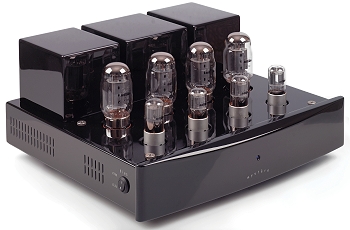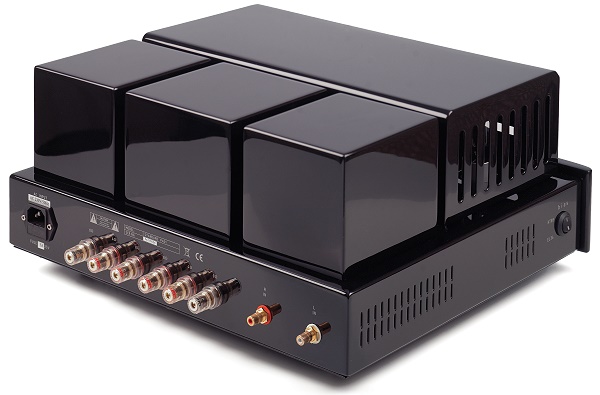Introduction
Durob Audio is a company in the Netherlands that markets PrimaLuna tubed audio components, including integrated amplifiers, power amplifiers, and a CD player that has a tube-based clock. It also has a discrete output stage with triodes running in pure Class A. Conventional CD players use op-amps in the output stage. Although the tube output stage and op-amp output stage sound different, one doesn’t necessarily sound “better” than the other, although tubeophiles would all opt for the “better”. We reviewed the PrimaLuna DiaLogue Two integrated amplifier in December, 2009.
With the introduction of Durob Audio’s Mysterè line, we now review the Mysterè pa21, which is a 55 watt per channel stereo tube power amplifier. The Mysterè line goes beyond the PrimaLuna line with larger transformers, more power supply capacitance, and an auto-bias circuit that lets the consumer choose between using KT88’s or EL34’s as the output tubes. Trying different tubes is one of the things that makes tube products fun, and those who participate in this activity are called “tube rollers”.
Specifications
- Design: Stereo Tube Power Amplifier, Push-Pull, Class AB
- Power Output: 55 Watts x 2 into 8 Ohms
- Tube Compliment: Four 6SN7, Four KT88
- MFR: 9 Hz – 52 kHz, ± 1 dB at 40 Watts Output
- THD+N: 1% at 55 Watts Output
- Input Impedance: 100 kOhms
- Inputs: RCA
- Outputs: Five-way Speaker Binding Posts
- Dimensions: 8″ H x 16.75″ W x 17″ D
- Weight: 60 Pounds
- MSRP: $2,995 USA
- Mystere USA
The Design
The pa21 has two gain stages, with the 6SN7s providing the input stage and the KT88’s at the output stage. You can substitute EL34’s for the KT88’s, and switch the toggle on the side to give the proper bias voltage for the EL34’s vs. the KT88’s.
The KT88, introduced in 1956, is a beam tetrode, and a schematic with pin-outs is shown below. The cathode (Pin 8) is indirectly heated by a filament (Pins 2 and 7, h). The control grid (Pin 5, g1) and screen grid (Pin 4, g2) are between the cathode and anode (Pin 3, a). (© Genalex)
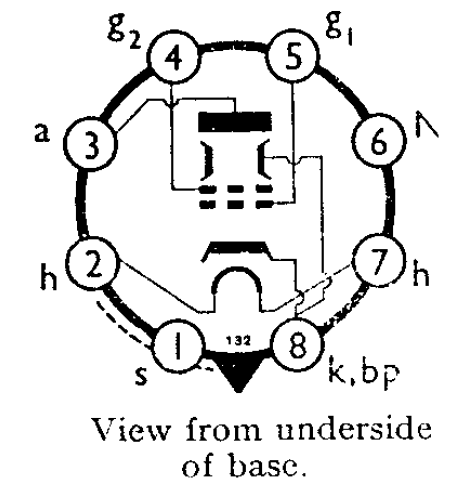
Here is a diagrammatic representation of a beam tetrode. The light green lines represent the “beam” of electrons that flows from the cathode towards the anode in the direction indicated by the arrows.
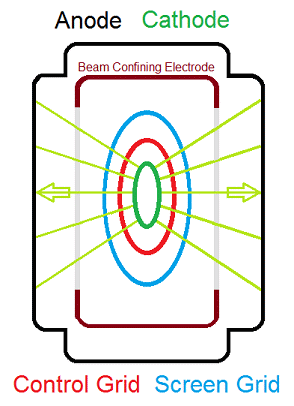
The EL34 is a pentode rather than a beam tetrode, and was developed by Philips in 1953. The KT88, developed by MO-Valve, could not be an actual pentode, because Philips held the patent. So, the pentode design was modified such that it became a beam tetrode. The first beam tetrode was the 6L6, which is still very popular in guitar amplifiers.
A generic diagram of a pentode is illustrated below. The numbers are not the pin socket numbers, but are just for identifying the structures in the diagram.
It has a cathode (2) which is indirectly heated by a filament (1), three grids (4,5, and 6), and the anode, also called the plate (3). It can be operated as a triode by connecting the grids together.
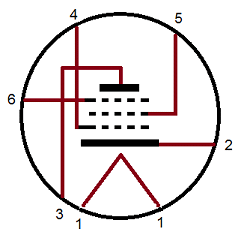
The 6SN7 is a dual triode, originating in 1939 from the US (the ECC32 is the European version). It was used as the driver stage in audio amplifiers, and is electrically similar to the 12AU7. It is still used quite often, such as in preamplifiers. Here is a schematic with the actual pin-out arrangement, as viewed from the bottom of the tube. Pins 7 and 8 are the heater for the two cathodes (6 and 7), pins 1 and 4 are the two grids, and pins 2 and 5 are the anodes (plates).
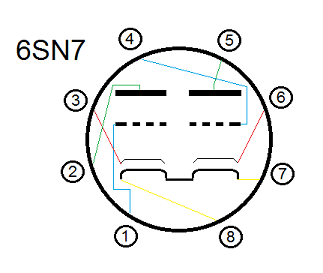
So, with the pa21, for each channel, there are two triodes in the input stage and two triodes in the driver stage (each channel has two 6SN7’s and there are two triodes in each tube), and two pentodes in the output stage. The input stage delivers the voltage, and the output stage delivers the current.
The chassis is gloss black enamel, and the cover for the tubes can be removed to aid in dissipating heat. But if you have small children, leave the cover on.
The rear panel has five-way speaker binding posts, with 8 ohm and 4 ohm “taps” (these are connected to different positions on the output transformer). The power on/off toggle is on one side and the KT88/EL34 toggle is on the other side. The AC power cord is grounded and detachable.
In Use
I tested the Mysterè pa21 with a McIntosh MCD500 SACD player, OPPO BDP-83SE/NuForce universal player, Lamm LL1 Reference preamplifier, and Carver Amazing Mark IV ribbon speakers. Cables were Emotiva and Legenburg.
One of the first things I noticed about the pa21 was that it did not roll off at the high frequencies or the deep bass. Many tube amps do roll off in these areas, and it is just something we put up with. The pa21 handled the natural harmonics of violins, and the lowest notes on a piano with ease. This is something I am not used to with tube components. Tubes themselves have a linear response into the megahertz, but it is the output transformer that limits the overall frequency response. In the case of the pa21, it has a huge output transformer, and this results in a better, deeper bass response.
The pa21 had a midrange lushness that I have come to expect. This is due to a tube amp’s natural tendency to produce mostly 2nd order harmonics, which you will see in the bench tests. It produced more distortion overall than a solid state amplifier might, and the argument never ends about why consumers are happy with that higher level of harmonics, even though they are “euphonic”, which means having a “sweet” sound. I am a huge fan of tubes myself, and love the characteristic that the high level of 2nd order harmonics imparts on the sound. The reason for this is that we can never really come up with an audio system that will truly reproduce the sound of a live orchestra in our listening room. It can come close, but no cigar. For a single instrument or a jazz quartet, maybe really close. Still no cigar though.
So, tubeophiles enjoy the addition of the sensory experience that 2nd order harmonics give us. This is not a term that fits within the framework of high fidelity. It is simply a sensation, and it is very pleasurable. You have to keep in mind that bench test graphs show harmonic peaks that look really big, but in fact, the Y axis is graphed exponentially, so those high peaks actually only represent about 1% distortion, or less. We would never tolerate that amount from a solid state amplifier because solid state tends to have more odd-order distortion, which is very unpleasant. Remember, all amplifiers have distortion. It is a matter of choosing your poison, so to speak – how much distortion and what type of distortion you are willing to accept. But you don’t have the choice of purchasing an amplifier with no distortion.
I listened to a lot of CDs and SACDs with the Mysterè, and I think what I enjoyed most was easy listening music with female singers. There was something about that midrange sweetness that made their voices just waft through my temporal lobe (the part of the brain’s cerebral cortext that is involved with emotion and hearing, among other things). Like I said, the sound was giving me not only her words and voice inflection, with piano, bass, and drums, but a sensation, and it was a sense of inner calm.


On the Bench
Distortion measurements were made within an 80 kHz bandwidth. Except where indicated, the load was 8 ohms.
Most of the time, we listen to our audio systems with just a few watts. Here is a 1 kHz sine wave test signal at 5 volts output (the left channel is represented by the yellow lines, and the right channel by red). There is 0.21% THD+N. That would be considered quite a bit in the solid state world. But for tubes, it is the norm. Notice that the 2nd order harmonic predominated.
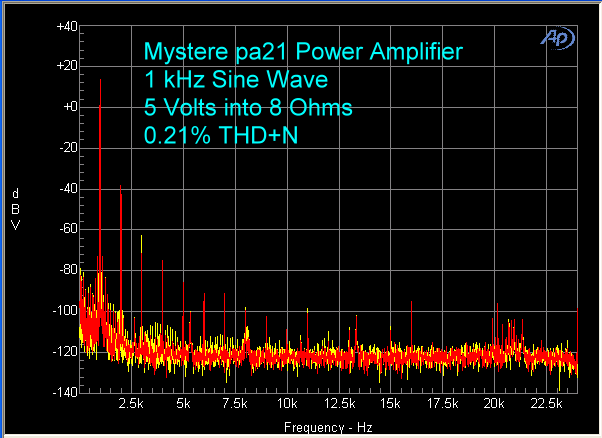
At 15 volts output, distortion rose to 0.38%, but the 2nd order harmonic was still the biggest one. Again, seeing all those tall peaks makes it look like there is a lot of distortion, but the Y axis is exponential, and this is really just so we can see the peaks more easily.

Compare the above graph to that taken from a solid state balanced push-pull power amplifier, shown below. The total distortion figure is lower by a factor of about 30. All of the even-order distortion products have been cancelled, leaving only odd-order harmonics. The total amount of distortion is about 1/100th of a percent. This is right about at the level of controversy as to whether the distortion can be heard. It’s likely not “heard”, but perhaps “sensed” in some form.

With 60 hz and 7 kHz sine waves, and 5 volts output, IMD measured 0.77%.
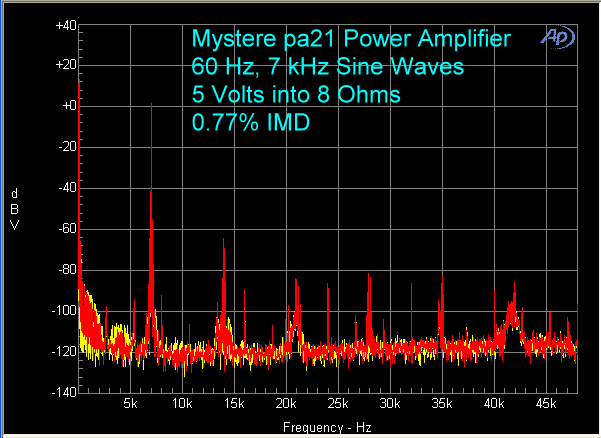
At 15 volts output, IMD rose to 1.47%. This appears to be a high number, but it’s often seen in tube components.
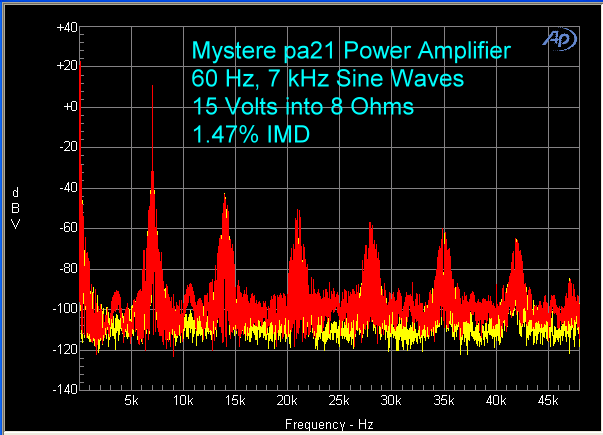
For 19 kHz and 20 kHz sine wave test signals, at 5 volts output, the B-A peak at 1 kHz was 52 dB below the fundamentals.
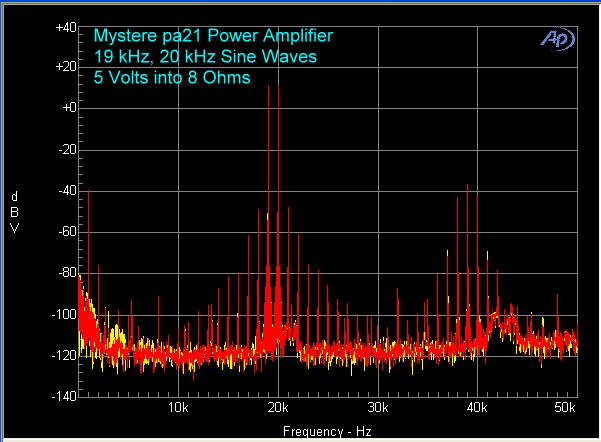
At 15 volts output, B-A was 36 dB below the fundamentals. Looks like a lot of distortion doesn’t it? But don’t critcize until you have listened.
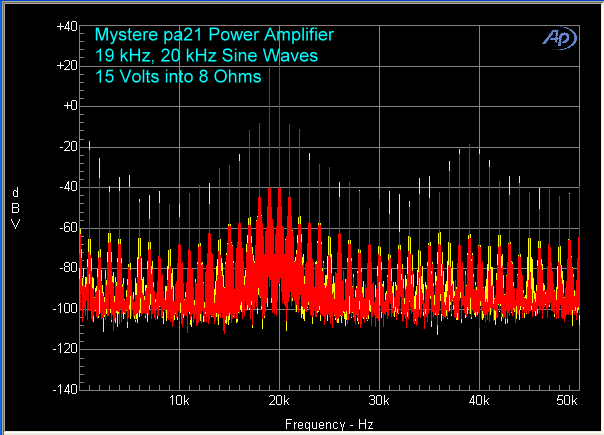
THD+N vs. Frequency indicated less than 1% distortion at output levels up to 15 volts into 8 ohms.
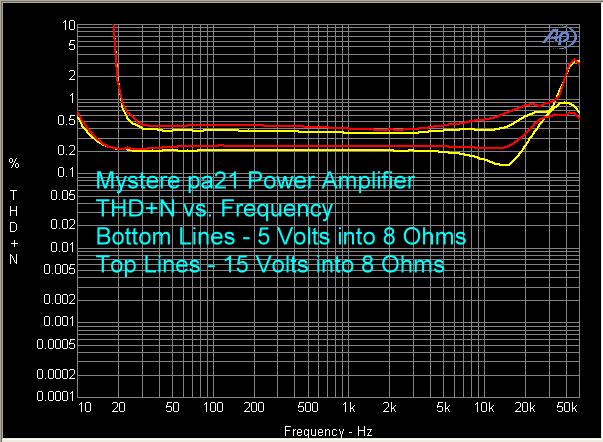
Power output didn’t quite make it to the specified output, but it was close. Because of these curves, I would suggest using the 8 ohm tap regardless of the speaker.
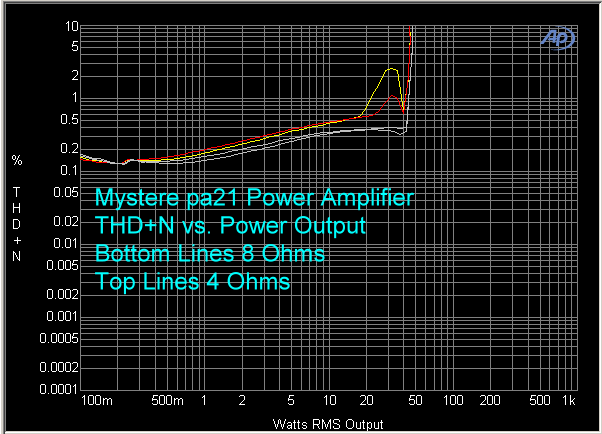
The measured frequency response was 20 Hz – 20 kHz, + 2 dB at 5 volts output. At 15 volts output tended to rise a bit at both the low end and high end.
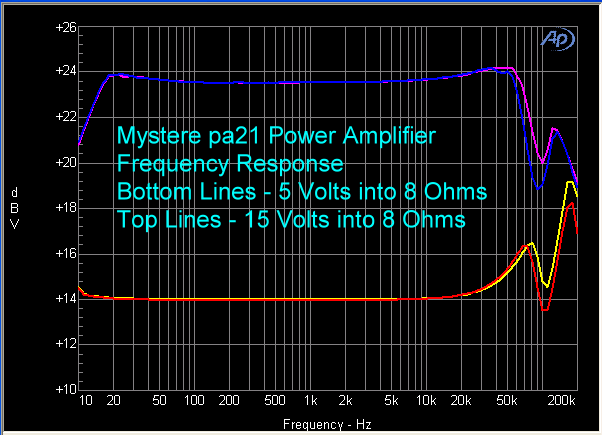
Conclusions
Tube amplifiers have made their comeback, and if you are a “Retro” kind of person, or just someone looking to go back to a full-bodied tube sound, the Mysterè pa21 is your kind of product. It’s beautiful to look at (the soft glow of the filaments in the evening adds to that peaceful sensation), reasonably priced, and delivers everything you might expect and desire from a tube amplifier.
The amp compares favorably with my reference units, but I play music very loud in many situations and I use speakers that are not very efficient, so I have to use amps with a lot more power, i.e., 1200 watt monoblocks. But the Mysterè has a sound of its own. I found it to be extremely pleasant to listen to in the evening, at low/moderate volume, while I was reading. You know, the glass of wine, fireplace going, cat on my lap kind of evenings. And this is the first June I have lived in California where I needed to use the fireplace. What is it with this weather?



